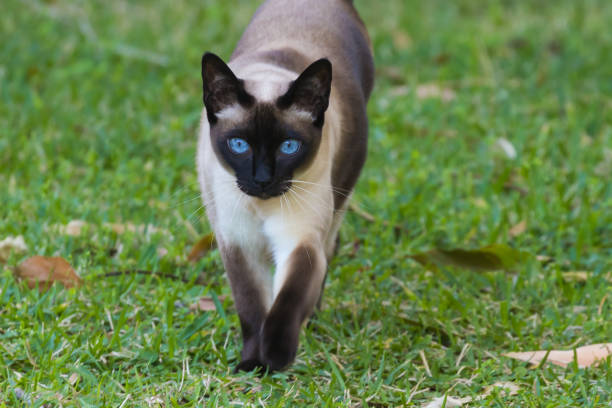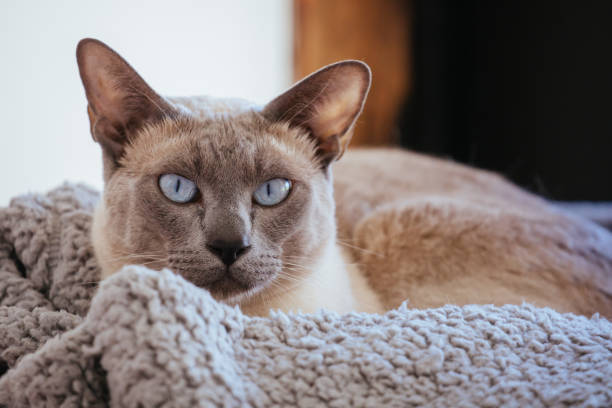Tonkinese Cat

History:
The Tonkinese cat is a hybrid breed that originated from crossing the Siamese and Burmese cats, aiming to blend the best traits of both. Though natural pairings of these breeds likely occurred in Southeast Asia, the intentional development of the Tonkinese began in the 1960s in North America. Breeders sought a cat with the Siamese’s vocal personality and the Burmese’s affectionate nature, resulting in a social, intelligent, and playful companion. The breed gained official recognition in the 1970s and is now loved for its engaging demeanour and moderate features, not as slender as the Siamese nor as stocky as the Burmese. Tonkinese cats are known for their loving temperament, aqua-colored eyes, and silky mink-like coats.
Size: Medium-sized cat
Height: 20–25 cm
Weight: 3–5.5 kg
Life Expectancy: 13 to 16 years

Breed Appearance:
The Tonkinese is a medium-sized, muscular cat with a balanced, athletic build that reflects its hybrid heritage. It has a gently rounded head, high cheekbones, and a slightly short, broad muzzle. The ears are medium-sized, slightly tilted forward, and set wide apart. Their most distinctive feature is their captivating almond-shaped eyes, which are typically aqua, though blue or green variants exist depending on coat colour.
The breed's short, soft, and fine coat has a silky texture and comes in a limited but beautiful range of colours known as “mink” patterns, with body colour gently shading into darker points. Common colours include champagne, blue, platinum, and natural (a warm brown). Tonkinese cats move with grace and energy, exuding a confident, inquisitive presence.
Health & Care:
The Tonkinese is generally a robust and healthy breed, but it may inherit some genetic predispositions from its Siamese and Burmese ancestors. These can include dental issues, respiratory problems, or congenital heart conditions such as hypertrophic cardiomyopathy. Regular vet visits and proactive health monitoring are recommended. Their short, low-shedding coat requires minimal grooming—occasional brushing keeps it soft and clean. A high-quality diet, dental hygiene, and plenty of physical and mental stimulation are essential for maintaining their overall well-being.

Living Conditions:
Tonkinese cats are highly adaptable and do well in various living environments, from busy family homes to apartments, as long as they receive adequate attention and stimulation. They crave human interaction and are happiest when included in daily life. These cats enjoy cozy sleeping spots, climbing areas, and windows to watch the world go by. Due to their affectionate and inquisitive personality, they make excellent companions in multi-pet households and get along with most other animals. Tonkinese cats are best suited to homes where they are not left alone frequently, as they can become lonely or stressed without companionship.
Grooming:
Tonkinese cats have a short, fine coat that is easy to maintain. Weekly brushing is usually sufficient to remove loose hair and keep their coat glossy and healthy. They are moderate shedders, with slightly more shedding during seasonal transitions. Routine care should include regular dental brushing, nail trimming, and ear checks. Baths are rarely needed due to the coat’s low oil content and self-cleaning nature. With consistent and basic grooming, Tonkinese cats remain clean, comfortable, and looking their best.

Advantages:
-
Tonkinese cats are affectionate, intelligent, and people-oriented, making them excellent companions who thrive in interactive and loving homes.
-
Their short, low-maintenance coat requires minimal grooming, making them easy to care for.
-
Playful and energetic, they enjoy games, training, and bonding activities, which provide enrichment for both cat and owner.
-
They usually get along well with children, other cats, and friendly dogs, making them suitable for multi-pet households.
-
Adaptable and outgoing, they love being part of family life and offer affectionate, loyal companionship.
Disadvantages:
-
Their need for attention and constant companionship can lead to separation anxiety if left alone for long periods.
-
They may become bored or destructive without enough physical and mental stimulation.
-
Though generally healthy, they can inherit genetic health issues that require regular monitoring and veterinary care.
-
Their talkative and social nature might be overwhelming for people seeking a quiet, independent pet.
-
Not ideal for households that cannot commit time to daily interaction, training, and active engagement.

